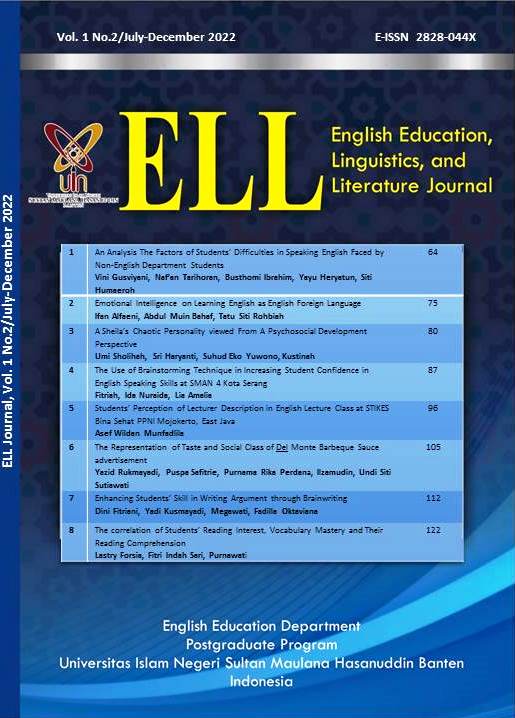The Correlation of Students’ Reading Interest, Vocabulary Mastery and Their Reading Comprehension
DOI:
https://doi.org/10.32678/ell.v1i2.6561Keywords:
Correlation, Reading Compehension, Reading Interest, Vocabulary MasteryAbstract
The study is aimed to find out The Correlation of Students’ Reading Interest, Vocabulary Mastery and Their Reading Comprehension at Tenth Grade of SMA Paradigma. The method of the research used quantitative research. The population was 175 students and 40 students as a sample. The result showed that (1) There is no positive significant correlation between students’ reading interest and their reading comprehension at SMA Paradigma Kabupaten Tangerang in Academic Year 2020/2021. With the value t_count < t_table (1,238 < 1,687). (2) There is positive significant correlation between students’ vocabulary mastery and their reading comprehesion at tenth grade of SMA Paradigma Kabupaten Tangerang in academic year 2020/2021. The result of the variable students’ vocabulary mastery is 2,473 which means t_count > t_table (2,473 > 1,687). (3) There is a positive simultaneous correlation of students’ reading interest, vocabulary mastery and their reading comprehension at tenth grade of SMA Paradigma Kabupaten Tangerang in academic year 2020/2021. The result of students’ reading interest and vocabulary mastery on their reading comprehension with a significance value of 0,005 < 0,05 it can be concluded that the greater the interest in reading, the greater their vocabulary mastery, and automatically students will have a good reading comprehension.
Downloads
References
Ainley, M., Hidi, S., & Berndorff, D. (2002). Interest, learning, and the psychological processes that mediate their relationship. Journal of Educational Psychology, 94(3), 545–561. https://doi.org/10.1037/0022-0663.94.3.545
Brown, H. D. (2004). Language Testing Book: Principles and Classroom Practice. Book, 314.
Geoffrey Marczyk, D. D. & D. F. (2005). Essentials of Research Design. John Wileyoken & Sons, Inc., Hoboken, New Jersey.
M. F Patel. (2008). English Language. Sunrise Publisher & Distributors.
Rush, S. M., Christensen, J. C., & Johnson, C. H. (2000). Biomechanics of the first ray. Part II: Metatarsus primus varus as a cause of hypermobility. A three-dimensional kinematic analysis in a cadaver model. Journal of Foot and Ankle Surgery, 39(2), 68–77. https://doi.org/10.1016/S1067-2516(00)80030-7
Schmitt, N. & M. M. (1997). Vocabulary : Description , Acquisition and Pedagogy Edited by. English, September, 122–139.
Septika Ariyanti & Aulia Hanifah Qomar. (2016). Vocabulary Mastery And Writing Ability In Recount. 2.
Siska Risdianti. (2020). The Correlation Between Students’ Reading Interest And Vocabulary Mastery With Reading Comprehension At Smkn 2 Ponorogo. Institute Of Islamic Studies Ponorogo.
Smith, T. (2008). Process Writing. Ebsco Research Strategies, July. Http://Www.Getcited.Org/Pub/102865384
Sugiyono. (2011). Metode Penelitian Kuantitatif Kualitatif Dan R&D. In Sifonoforos (Vol. 1, Issue August 2015). Alfabeta, Cv.
Suharsimi Arikunto. (2010). Scanned By Camscanner. Pt. Rineka Cipta, Jakarta.
Downloads
Published
Issue
Section
License
Copyright (c) 2022 Purnawati purnawati, Lastry Forsia, Fitri Indah Sari

This work is licensed under a Creative Commons Attribution-ShareAlike 4.0 International License.






